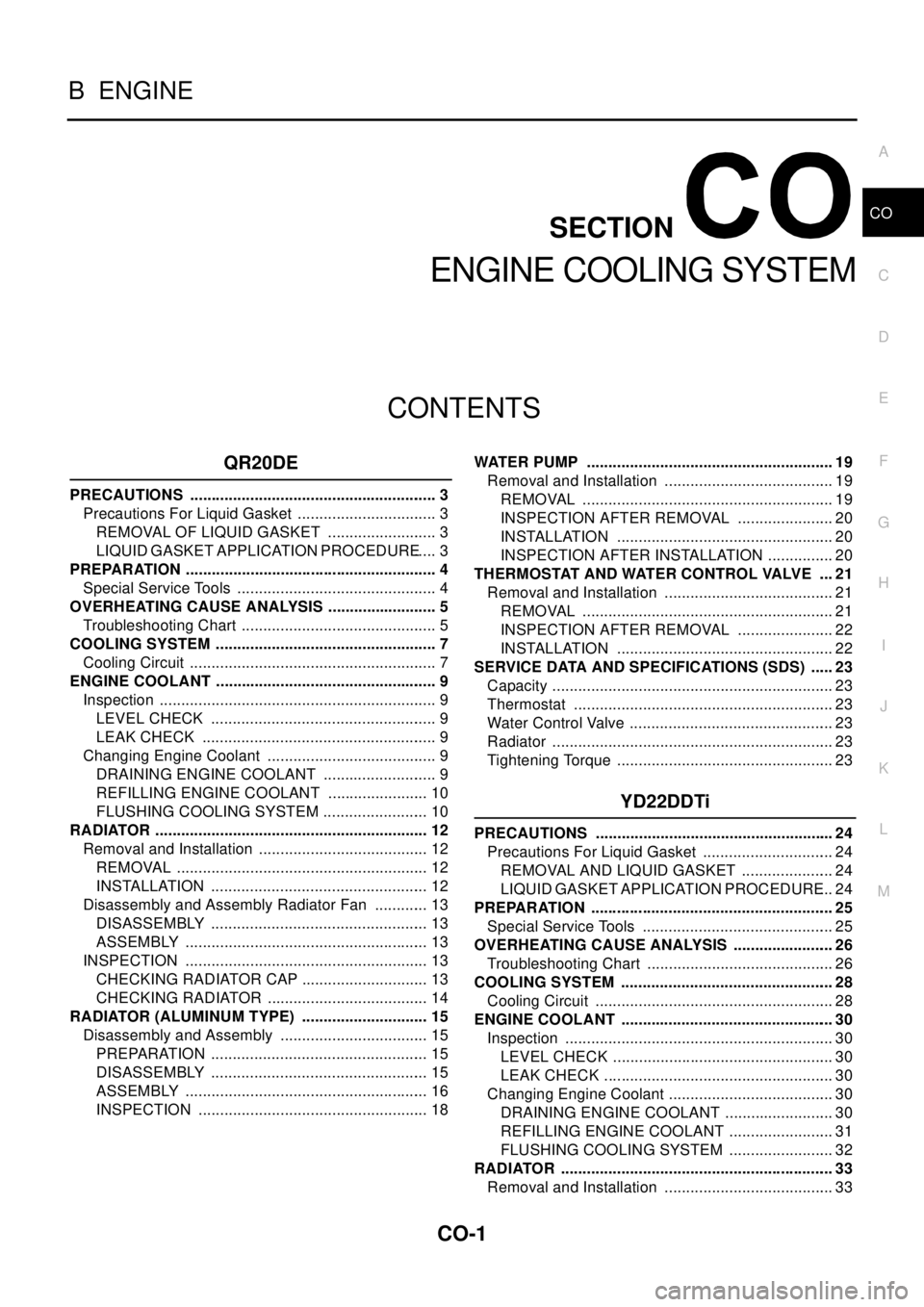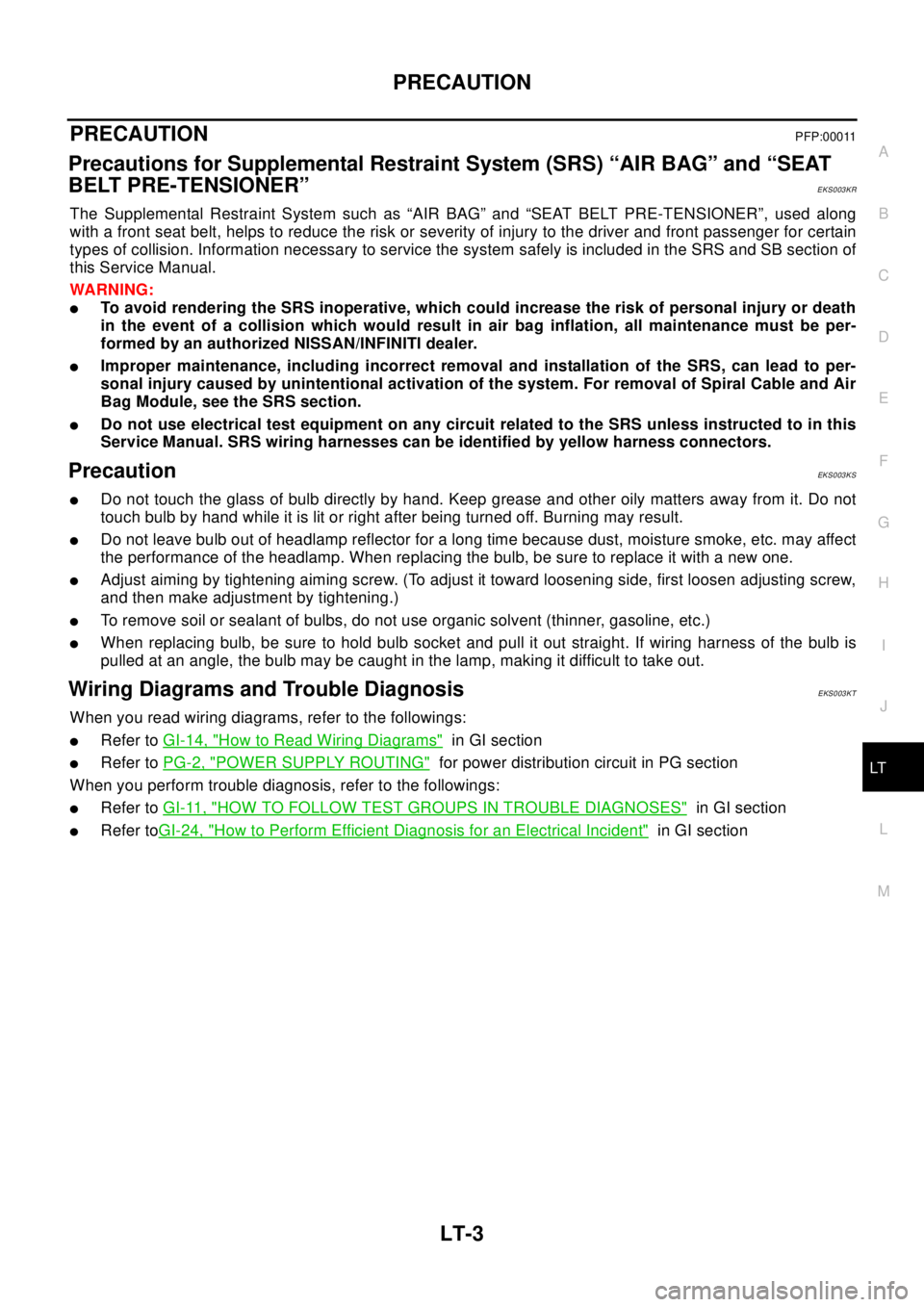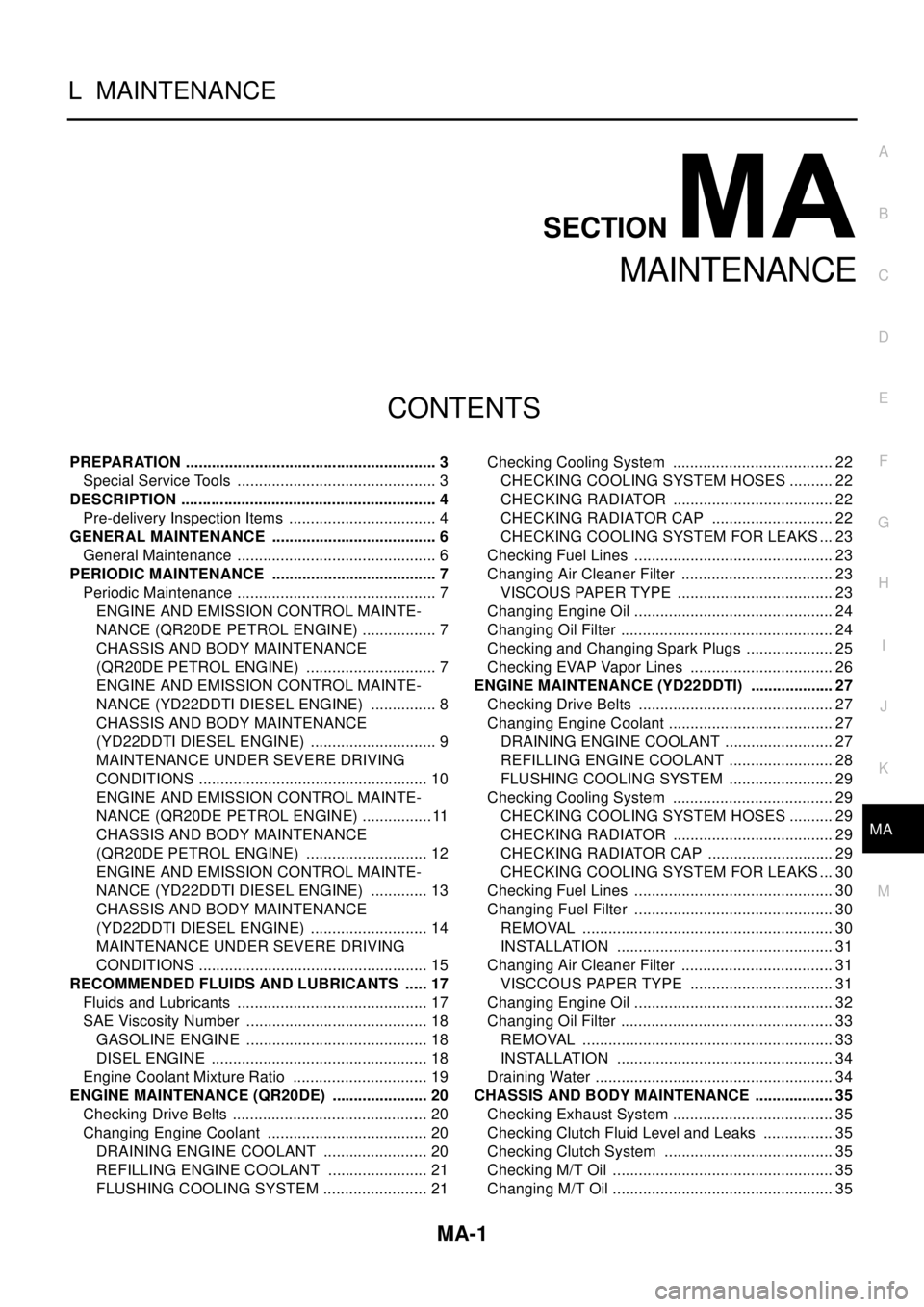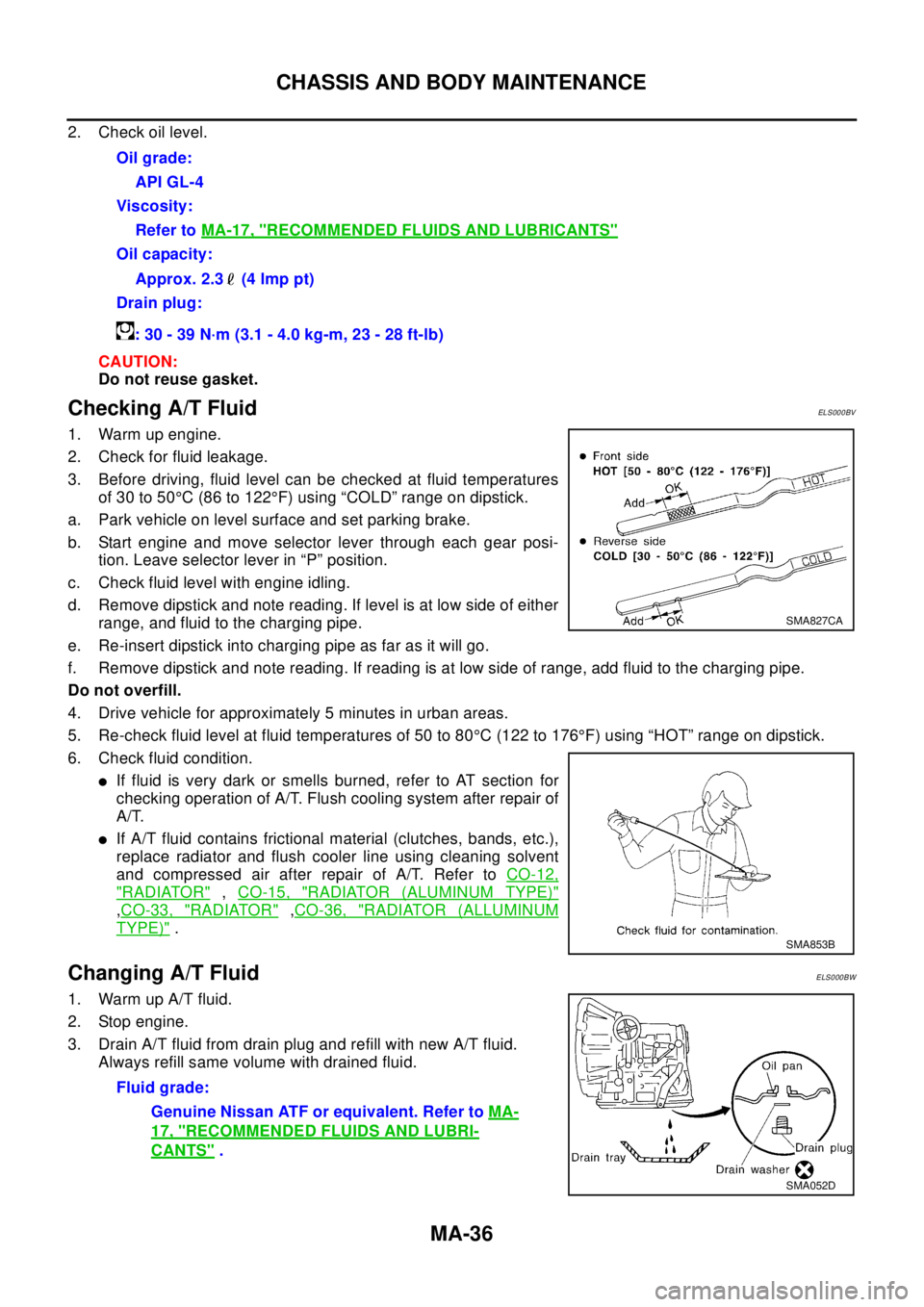2003 NISSAN X-TRAIL gas type
[x] Cancel search: gas typePage 872 of 3066
![NISSAN X-TRAIL 2003 Electronic Repair Manual BRC-4
[4WD/ABS]
PRECAUTIONS
[4WD/ABS]PRECAUTIONSPFP:00001
Precautions for brake systemEFS001B6
lRecommended fluid is brake fluid “DOT 3 ”or “DOT 4”.
lNever reuse drained brake fluid.
lBe caref NISSAN X-TRAIL 2003 Electronic Repair Manual BRC-4
[4WD/ABS]
PRECAUTIONS
[4WD/ABS]PRECAUTIONSPFP:00001
Precautions for brake systemEFS001B6
lRecommended fluid is brake fluid “DOT 3 ”or “DOT 4”.
lNever reuse drained brake fluid.
lBe caref](/manual-img/5/57402/w960_57402-871.png)
BRC-4
[4WD/ABS]
PRECAUTIONS
[4WD/ABS]PRECAUTIONSPFP:00001
Precautions for brake systemEFS001B6
lRecommended fluid is brake fluid “DOT 3 ”or “DOT 4”.
lNever reuse drained brake fluid.
lBe careful not to splash brake fluid on painted areas.
lTo clean or wash all parts of master cylinder, disc brake caliper and wheel cylinder, use clean brake fluid.
lNever use mineral oils such as gasoline or kerosene. They will ruin rubber parts of the hydraulic system.
lUse flare nut wrench when removing and installing brake tube.
lAlways torque brake lines when installing.
lBurnish the brake contact surfaces after refinishing or replacing
drums or rotors, after replacing pads or linings, or if a soft pedal
occurs at very low mileage. Refer toBR-10, "
Brake Burnishing
Procedure".
lBefore working, turn OFF ignition switch. Disconnect connectors
for ABS actuator and control module or battery terminals.
WAR NIN G:
lClean brake pads and shoes with a waste cloth, then wipe
with a dust collector.
Precautions for brake controlEFS001B7
lIf malfunction is indicated by 4WD warning lamp and/or ABS warning lamp, collect necessary information
from customer (what symptoms are present under what conditions). Find out possible causes before start-
ing service. Besides electrical system inspection, check operation of ABS actuator.
lIf malfunction is detected, proceed to trouble diagnosis after checking tire pressure and tire wear.
lStopping distance or steering stability may be deteriorated by the following conditions. Tire size and type
are in improper combination. Brake pads are not Nissan genuine parts.
lFitting tires of different size on vehicle can be cause of longitudinal vibration. Always use tires of the same
size and brand. Exchange front and rear tires on the following conditions: Longitudinal vibration occurs in
vehicle with tires of the same size and brand. After replacement, perform trouble diagnosis. 1580|None
l4WD/ABS function may have a failure or error under following condition: There is radio, antenna, or
antenna lead-in wire (including wiring) near control module.
lIf aftermarket parts (e.g. Car stereo equipment, CD player) have been installed, check electrical har-
nesses for pinches, open, and improper wiring.
SBR686C
Page 920 of 3066
![NISSAN X-TRAIL 2003 Electronic Repair Manual BRC-52
[ESP/TCS/ABS]
PRECAUTIONS
[ESP/TCS/ABS]PRECAUTIONSPFP:00001
Precautions for Supplemental Restraint System (SRS) “AIR BAG” and “SEAT
BELT PRE-TENSIONER”
EFS0019N
The Supplemental Restrai NISSAN X-TRAIL 2003 Electronic Repair Manual BRC-52
[ESP/TCS/ABS]
PRECAUTIONS
[ESP/TCS/ABS]PRECAUTIONSPFP:00001
Precautions for Supplemental Restraint System (SRS) “AIR BAG” and “SEAT
BELT PRE-TENSIONER”
EFS0019N
The Supplemental Restrai](/manual-img/5/57402/w960_57402-919.png)
BRC-52
[ESP/TCS/ABS]
PRECAUTIONS
[ESP/TCS/ABS]PRECAUTIONSPFP:00001
Precautions for Supplemental Restraint System (SRS) “AIR BAG” and “SEAT
BELT PRE-TENSIONER”
EFS0019N
The Supplemental Restraint System such as “AIR BAG” and “SEAT BELT PRE-TENSIONER”, used along
with a front seat belt, helps to reduce the risk or severity of injury to the driver and front passenger for certain
types of collision. Information necessary to service the system safely is included in the SRS and SB section of
this Service Manual.
WAR NIN G:
lTo avoid rendering the SRS inoperative, which could increase the risk of personal injury or death
in the event of a collision which would result in air bag inflation, all maintenance must be per-
formed by an authorized NISSAN/INFINITI dealer.
lImproper maintenance, including incorrect removal and installation of the SRS, can lead to per-
sonal injury caused by unintentional activation of the system. For removal of Spiral Cable and Air
Bag Module, see the SRS section.
lDo not use electrical test equipment on any circuit related to the SRS unless instructed to in this
Service Manual. SRS wiring harnesses can be identified by yellow harness connector.
Precautions for Brake SystemEFS0019O
lRecommended fluid is brake fluid “DOT 3” or “DOT 4”.
lNever reuse drained brake fluid.
lBe careful not to splash brake fluid on painted areas; it may cause paint damage. If brake fluid is splashed
on painted areas, wash it away with water immediately.
lNever use mineral oils such as gasoline or kerosene. They will ruin rubber parts of hydraulic system.
lUse flare nut wrench when removing and installing brake tubes.
lAlways torque brake lines when installing.
lBefore working, turn the ignition switch OFF and disconnect the
connectors for the ESP/TCS/ABS actuator and control unit or
the battery terminals.
lBurnish the brake contact surfaces after refinishing or replacing
drums or rotors, after replacing pads or linings, or if a soft pedal
occurs at very low mileage. Refer toBR-10, "
Brake Burnishing
Procedure".
WAR NIN G:
Clean brakes with a vacuum dust collector to minimize risk
of health hazard from powder caused by friction.
Precautions for Brake ControlEFS0019P
lDuring the EPS/TCS/ABS operation, the brake pedal vibrates lightly and its mechanical noise may be
heard. This is a normal condition.
lJust after starting the vehicle after ignition switch ON, the brake pedal may vibrate or the motor operating
noise may be heard from the engine compartment. This is a normal status of the operation check.
lThe stopping distance may be longer than that of vehicles without ABS when the vehicle drives on rough,
gravel, or snowy (fresh deep snow) road.
lIf a malfunction is indicated by the ABS warning lamp, or other warning lamps, collect the necessary infor-
mation from the customer (what symptoms are present under what conditions) and find out the possible
causes before starting the service. Besides the electrical system inspection, check the booster operation,
brake fluid level, and oil leaks.
lIf the tire size and type are used in a improper combination, or the brake pads are not NISSAN genuine
parts, the stopping distance or steering stability may deteriorate.
lIf there is a radio, antenna, or antenna lead-in wire (including wiring) near the control unit, the ESP/TCS/
ABS function may have a malfunction or error.
lIf aftermarket parts (e.g. Car stereo equipment, CD player) have been installed, check the electrical har-
nesses for pinches, open, and improper wiring.
SBR686C
Page 1011 of 3066

CO-1
ENGINE COOLING SYSTEM
B ENGINE
CONTENTS
C
D
E
F
G
H
I
J
K
L
M
SECTION
A
CO
ENGINE COOLING SYSTEM
QR20DE
PRECAUTIONS .......................................................... 3
Precautions For Liquid Gasket ................................. 3
REMOVAL OF LIQUID GASKET .......................... 3
LIQUID GASKET APPLICATION PROCEDURE..... 3
PREPARATION ........................................................... 4
Special Service Tools ............................................... 4
OVERHEATING CAUSE ANALYSIS .......................... 5
Troubleshooting Chart .............................................. 5
COOLING SYSTEM .................................................... 7
Cooling Circuit .......................................................... 7
ENGINE COOLANT .................................................... 9
Inspection ................................................................. 9
LEVEL CHECK ..................................................... 9
LEAK CHECK ....................................................... 9
Changing Engine Coolant ........................................ 9
DRAINING ENGINE COOLANT ........................... 9
REFILLING ENGINE COOLANT ........................ 10
FLUSHING COOLING SYSTEM ......................... 10
RADIATOR ................................................................ 12
Removal and Installation ........................................ 12
REMOVAL ........................................................... 12
INSTALLATION ................................................... 12
Disassembly and Assembly Radiator Fan ............. 13
DISASSEMBLY ................................................... 13
ASSEMBLY ......................................................... 13
INSPECTION ......................................................... 13
CHECKING RADIATOR CAP .............................. 13
CHECKING RADIATOR ...................................... 14
RADIATOR (ALUMINUM TYPE) .............................. 15
Disassembly and Assembly ................................... 15
PREPARATION ................................................... 15
DISASSEMBLY ................................................... 15
ASSEMBLY ......................................................... 16
INSPECTION ...................................................... 18WATER PUMP .......................................................... 19
Removal and Installation ........................................ 19
REMOVAL ........................................................... 19
INSPECTION AFTER REMOVAL ....................... 20
INSTALLATION ................................................... 20
INSPECTION AFTER INSTALLATION ................ 20
THERMOSTAT AND WATER CONTROL VALVE .... 21
Removal and Installation ........................................ 21
REMOVAL ........................................................... 21
INSPECTION AFTER REMOVAL ....................... 22
INSTALLATION ................................................... 22
SERVICE DATA AND SPECIFICATIONS (SDS) ...... 23
Capacity .................................................................. 23
Thermostat ............................................................. 23
Water Control Valve ................................................ 23
Radiator .................................................................. 23
Tightening Torque ................................................... 23
YD22DDTi
PRECAUTIONS ........................................................ 24
Precautions For Liquid Gasket ............................... 24
REMOVAL AND LIQUID GASKET ...................... 24
LIQUID GASKET APPLICATION PROCEDURE... 24
PREPARATION ......................................................... 25
Special Service Tools ............................................. 25
OVERHEATING CAUSE ANALYSIS ........................ 26
Troubleshooting Chart ............................................ 26
COOLING SYSTEM .................................................. 28
Cooling Circuit ........................................................ 28
ENGINE COOLANT .................................................. 30
Inspection ............................................................... 30
LEVEL CHECK .................................................... 30
LEAK CHECK ...................................................... 30
Changing Engine Coolant ....................................... 30
DRAINING ENGINE COOLANT .......................... 30
REFILLING ENGINE COOLANT ......................... 31
FLUSHING COOLING SYSTEM ......................... 32
RADIATOR ................................................................ 33
Removal and Installation ........................................ 33
Page 1323 of 3066
![NISSAN X-TRAIL 2003 Electronic Repair Manual DTC P0300 - P0304 MULTIPLE CYLINDER MISFIRE, NO. 1 - 4 CYLINDER MIS-
FIRE
EC-209
[QR (WITH EURO-OBD)]
C
D
E
F
G
H
I
J
K
L
MA
EC
5.CHECK IGNITION SPARK
1. Disconnect ignition coil assembly from rocker NISSAN X-TRAIL 2003 Electronic Repair Manual DTC P0300 - P0304 MULTIPLE CYLINDER MISFIRE, NO. 1 - 4 CYLINDER MIS-
FIRE
EC-209
[QR (WITH EURO-OBD)]
C
D
E
F
G
H
I
J
K
L
MA
EC
5.CHECK IGNITION SPARK
1. Disconnect ignition coil assembly from rocker](/manual-img/5/57402/w960_57402-1322.png)
DTC P0300 - P0304 MULTIPLE CYLINDER MISFIRE, NO. 1 - 4 CYLINDER MIS-
FIRE
EC-209
[QR (WITH EURO-OBD)]
C
D
E
F
G
H
I
J
K
L
MA
EC
5.CHECK IGNITION SPARK
1. Disconnect ignition coil assembly from rocker cover.
2. Connect a known good spark plug to the ignition coil assembly.
3. Place end of spark plug against a suitable ground and crank engine.
4. Check for spark.
OK or NG
OK >> GO TO 6.
NG >> Check ignition coil, power transistor and their circuits.
Refer toEC-334, "
IGNITION SIGNAL".
6.CHECK SPARK PLUGS
Remove the spark plugs and check for fouling, etc.
OK or NG
OK >> GO TO 7.
NG >> Repair or replace spark plug(s) with standard type
one(s). For spark plug type, refer toMA-25, "
Checking
and Changing Spark Plugs".
7.CHECK COMPRESSION PRESSURE
Check compression pressure. Refer toEM-52, "
CHECKING COMPRESSION PRESSURE".
OK or NG
OK >> GO TO 8.
NG >> Check pistons, piston rings, valves, valve seats and cylinder head gaskets.
8.CHECK FUEL PRESSURE
1. Install all removed parts.
2. Release fuel pressure to zero. Refer toEC-34, "
FUEL PRESSURE RELEASE".
3. Install fuel pressure gauge and check fuel pressure. Refer toEC-34, "
FUEL PRESSURE CHECK".
OK or NG
OK >> GO TO 9.
NG >> Follow the construction of "FUEL PRESSURE CHECK".
SEF575Q
SEF156I
Standard:
1,190 kPa (11.9 bar, 12.1 kg/cm2, 172 psi)/250
rpm
Minimum:
990 kPa (9.9 bar, 10.1 kg/cm
2, 144 psi)/250 rpm
Difference between each
cylinder:98 kPa (0.98 bar, 1.0 kg/cm
2, 14 psi)/250 rpm
At idle: Approx. 350 kPa (3.5 bar, 3.7 kg/cm
2,51psi)
Page 2401 of 3066

PRECAUTION
LT-3
C
D
E
F
G
H
I
J
L
MA
B
LT
PRECAUTIONPFP:00011
Precautions for Supplemental Restraint System (SRS) “AIR BAG” and “SEAT
BELT PRE-TENSIONER”
EKS003KR
The Supplemental Restraint System such as “AIR BAG” and “SEAT BELT PRE-TENSIONER”, used along
with a front seat belt, helps to reduce the risk or severity of injury to the driver and front passenger for certain
types of collision. Information necessary to service the system safely is included in the SRS and SB section of
this Service Manual.
WA RN ING:
lTo avoid rendering the SRS inoperative, which could increase the risk of personal injury or death
in the event of a collision which would result in air bag inflation, all maintenance must be per-
formed by an authorized NISSAN/INFINITI dealer.
lImproper maintenance, including incorrect removal and installation of the SRS, can lead to per-
sonal injury caused by unintentional activation of the system. For removal of Spiral Cable and Air
Bag Module, see the SRS section.
lDo not use electrical test equipment on any circuit related to the SRS unless instructed to in this
Service Manual. SRS wiring harnesses can be identified by yellow harness connectors.
PrecautionEKS003KS
lDo not touch the glass of bulb directly by hand. Keep grease and other oily matters away from it. Do not
touch bulb by hand while it is lit or right after being turned off. Burning may result.
lDo not leave bulb out of headlamp reflector for a long time because dust, moisture smoke, etc. may affect
the performance of the headlamp. When replacing the bulb, be sure to replace it with a new one.
lAdjust aiming by tightening aiming screw. (To adjust it toward loosening side, first loosen adjusting screw,
and then make adjustment by tightening.)
lTo remove soil or sealant of bulbs, do not use organic solvent (thinner, gasoline, etc.)
lWhen replacing bulb, be sure to hold bulb socket and pull it out straight. If wiring harness of the bulb is
pulled at an angle, the bulb may be caught in the lamp, making it difficult to take out.
Wiring Diagrams and Trouble DiagnosisEKS003KT
Whenyoureadwiringdiagrams,refertothefollowings:
lRefer toGI-14, "How to Read Wiring Diagrams"in GI section
lRefer toPG-2, "POWER SUPPLY ROUTING"for power distribution circuit in PG section
When you perform trouble diagnosis, refer to the followings:
lRefer toGI-11, "HOW TO FOLLOW TEST GROUPS IN TROUBLE DIAGNOSES"in GI section
lRefer toGI-24, "How to Perform Efficient Diagnosis for an Electrical Incident"in GI section
Page 2493 of 3066

MA-1
MAINTENANCE
L MAINTENANCE
CONTENTS
C
D
E
F
G
H
I
J
K
M
SECTION
A
B
MA
MAINTENANCE
PREPARATION ........................................................... 3
Special Service Tools ............................................... 3
DESCRIPTION ............................................................ 4
Pre-delivery Inspection Items ................................... 4
GENERAL MAINTENANCE ....................................... 6
General Maintenance ............................................... 6
PERIODIC MAINTENANCE ....................................... 7
Periodic Maintenance ............................................... 7
ENGINE AND EMISSION CONTROL MAINTE-
NANCE (QR20DE PETROL ENGINE) .................. 7
CHASSIS AND BODY MAINTENANCE
(QR20DE PETROL ENGINE) ............................... 7
ENGINE AND EMISSION CONTROL MAINTE-
NANCE (YD22DDTI DIESEL ENGINE) ................ 8
CHASSIS AND BODY MAINTENANCE
(YD22DDTI DIESEL ENGINE) .............................. 9
MAINTENANCE UNDER SEVERE DRIVING
CONDITIONS ...................................................... 10
ENGINE AND EMISSION CONTROL MAINTE-
NANCE (QR20DE PETROL ENGINE) .................11
CHASSIS AND BODY MAINTENANCE
(QR20DE PETROL ENGINE) ............................. 12
ENGINE AND EMISSION CONTROL MAINTE-
NANCE (YD22DDTI DIESEL ENGINE) .............. 13
CHASSIS AND BODY MAINTENANCE
(YD22DDTI DIESEL ENGINE) ............................ 14
MAINTENANCE UNDER SEVERE DRIVING
CONDITIONS ...................................................... 15
RECOMMENDED FLUIDS AND LUBRICANTS ...... 17
Fluids and Lubricants ............................................. 17
SAE Viscosity Number ........................................... 18
GASOLINE ENGINE ........................................... 18
DISEL ENGINE ................................................... 18
Engine Coolant Mixture Ratio ................................ 19
ENGINE MAINTENANCE (QR20DE) ....................... 20
Checking Drive Belts .............................................. 20
Changing Engine Coolant ...................................... 20
DRAINING ENGINE COOLANT ......................... 20
REFILLING ENGINE COOLANT ........................ 21
FLUSHING COOLING SYSTEM ......................... 21Checking Cooling System ...................................... 22
CHECKING COOLING SYSTEM HOSES ........... 22
CHECKING RADIATOR ...................................... 22
CHECKING RADIATOR CAP ............................. 22
CHECKING COOLING SYSTEM FOR LEAKS ... 23
Checking Fuel Lines ............................................... 23
Changing Air Cleaner Filter .................................... 23
VISCOUS PAPER TYPE ..................................... 23
Changing Engine Oil ............................................... 24
Changing Oil Filter .................................................. 24
Checking and Changing Spark Plugs ..................... 25
Checking EVAP Vapor Lines .................................. 26
ENGINE MAINTENANCE (YD22DDTI) .................... 27
Checking Drive Belts .............................................. 27
Changing Engine Coolant ....................................... 27
DRAINING ENGINE COOLANT .......................... 27
REFILLING ENGINE COOLANT ......................... 28
FLUSHING COOLING SYSTEM ......................... 29
Checking Cooling System ...................................... 29
CHECKING COOLING SYSTEM HOSES ........... 29
CHECKING RADIATOR ...................................... 29
CHECKING RADIATOR CAP .............................. 29
CHECKING COOLING SYSTEM FOR LEAKS ... 30
Checking Fuel Lines ............................................... 30
Changing Fuel Filter ............................................... 30
REMOVAL ........................................................... 30
INSTALLATION ................................................... 31
Changing Air Cleaner Filter .................................... 31
VISCCOUS PAPER TYPE .................................. 31
Changing Engine Oil ............................................... 32
Changing Oil Filter .................................................. 33
REMOVAL ........................................................... 33
INSTALLATION ................................................... 34
Draining Water ........................................................ 34
CHASSIS AND BODY MAINTENANCE ................... 35
Checking Exhaust System ...................................... 35
Checking Clutch Fluid Level and Leaks ................. 35
Checking Clutch System ........................................ 35
Checking M/T Oil .................................................... 35
Changing M/T Oil .................................................... 35
Page 2509 of 3066

RECOMMENDED FLUIDS AND LUBRICANTS
MA-17
C
D
E
F
G
H
I
J
K
MA
B
MA
RECOMMENDED FLUIDS AND LUBRICANTSPFP:00000
Fluids and LubricantsELS000C8
*1: For further details, see “SAE Viscosity Number”.
*2: Never use API CG-4.
*3: Use Genuine Nissan Anti-freeze Coolant (L2N)] or equivalent in its quality, in order to avoid possible aluminum corrosion within the
engine cooling system caused by the use of non-genuine engine coolant.
Note that any repairs for the incidents within the engine cooling system while using non-genuine engine coolant may not be
covered by the warranty even if such incidents occurred during the warranty period.
*4: Contact a Nissan dealership for more information regarding suitable fluids, including recommended brand(s) of Dexron
TMIII/Mer-
conTMAutomatic Transmission Fluid.
*5: Never mix different types of fluids (DOT 3 and DOT 4).Capacity (Approximate)
Recommended Fluids/Lubricants
Liter Imp measure
Engine oil
Drain and refillWith oil filter
changeQR20DE 3.9 3-3/8 qt
lGasoline engine
API SG, SH or SJ*1
ILSAC grade GF-I or GF-II*1
ACEA 96-A2
lDiesel engine
API CF-4*1, *2
ACEA 98-B1 YD22DDTi 5.2 4-5/8 qt
Without oil filter
changeQR20DE 3.5 3-1/8 qt
YD22DDTi 4.9 4-3/8 qt
Dry engine (engine overhaul)QR20DE 4.5 4 qt
YD22DDTi 6.3 5-1/2 qt
Cooling system (with reservoir)QR20DE 7.1 6-1/4 qt
lGenuine Nissan Anti-freeze Coolant (L2N) or
equivalent in its quality*3 YD22DDTi 9.5 8-3/8 qt
Reservoir tankQR20DE 0.6 1/2 qt
YD22DDTi 0.6 1/2 qt
Manual transaxle gear oil
2.3 4pt
lGenuine Nissan gear oil or API GL-4, Viscosity
SAE 75W-85
Transfer gear oil 0.31 1/2 pt
lAPI GL-5*1, Viscosity SAE 80W-90
Differential gear oil 0.55 1 pt
lAPI GL-5*1, Viscosity SAE 80W-90
Automatic transaxle fluid 8.0 7.01 pt Genuine Nissan ATF or equivalent*4
Power steering fluid — —
Ty p e D e x r o n
TMIII or equivalent
Brake and clutch fluid — —
lDOT 3 or DOT 4 (US FMVSS No. 116)*5
Multi-purpose grease — — NLGI No. 2 (Lithium soap base)
Page 2528 of 3066

MA-36
CHASSIS AND BODY MAINTENANCE
2. Check oil level.
CAUTION:
Do not reuse gasket.
Checking A/T FluidELS000BV
1. Warm up engine.
2. Check for fluid leakage.
3. Before driving, fluid level can be checked at fluid temperatures
of 30 to 50°C (86 to 122°F) using “COLD” range on dipstick.
a. Park vehicle on level surface and set parking brake.
b. Start engine and move selector lever through each gear posi-
tion. Leave selector lever in “P” position.
c. Check fluid level with engine idling.
d. Remove dipstick and note reading. If level is at low side of either
range, and fluid to the charging pipe.
e. Re-insert dipstick into charging pipe as far as it will go.
f. Remove dipstick and note reading. If reading is at low side of range, add fluid to the charging pipe.
Do not overfill.
4. Drive vehicle for approximately 5 minutes in urban areas.
5. Re-check fluid level at fluid temperatures of 50 to 80°C (122 to 176°F) using “HOT” range on dipstick.
6. Check fluid condition.
lIf fluid is very dark or smells burned, refer to AT section for
checking operation of A/T. Flush cooling system after repair of
A/T.
lIf A/T fluid contains frictional material (clutches, bands, etc.),
replace radiator and flush cooler line using cleaning solvent
and compressed air after repair of A/T. Refer toCO-12,
"RADIATOR",CO-15, "RADIATOR (ALUMINUM TYPE)"
,CO-33, "RADIATOR",CO-36, "RADIATOR (ALLUMINUM
TYPE)".
Changing A/T FluidELS000BW
1. Warm up A/T fluid.
2. Stop engine.
3. Drain A/T fluid from drain plug and refill with new A/T fluid.
Always refill same volume with drained fluid.Oil grade:
API GL-4
Viscosity:
Refer toMA-17, "
RECOMMENDED FLUIDS AND LUBRICANTS"
Oil capacity:
Approx. 2.3 (4 lmp pt)
Drain plug:
: 30 - 39 N·m (3.1 - 4.0 kg-m, 23 - 28 ft-lb)
SMA827CA
SMA853B
Fluid grade:
Genuine Nissan ATF or equivalent. Refer toMA-
17, "RECOMMENDED FLUIDS AND LUBRI-
CANTS".
SMA052D